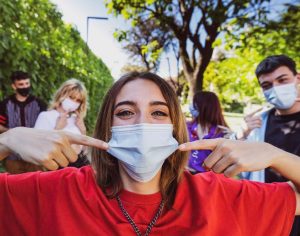Diverse young people among the most disadvantaged by the pandemic
Young people from migrant and refugee backgrounds were among the most negatively affected by the COVID-19 pandemic lockdowns, a new study has found.
The latest Longitudinal Surveys of Australian Youth (LSAY) report shows the COVID-19 pandemic held young Australians back from making their usual transitions.
‘Treading water: effects of the COVID-19 pandemic on youth transitions’ examined the lived experiences of young people aged about 20 in 2020, during the second wave of COVID-19 infections in Australia.
The study shows that between 2019 and 2020, typical transitions into employment and permanent or ongoing roles did not occur for a significant proportion of young people, running counter to historical patterns of those who were aged 19 and 20 in previous years.
It said young people who are female, Indigenous, with disabilities or from migrant or refugee backgrounds, as well as those from regional or remote areas, were particularly vulnerable.
“This vulnerability stems in part from their over-representation in sectors disproportionately affected by lockdowns, such as retail and hospitality, along with higher expectations to perform caring duties within families or communities at the expense of personal opportunities,” the report said.
“Young people with disabilities, or who come from languages-other-than-English (LOTE) speaking backgrounds, or who are from regional or remote areas, are also disadvantaged by the so-called ‘digital divide’, experiencing increased difficulties transferring to the online delivery of education programs and working from home arrangements,” it said.
 The report said the pandemic appeared to have taken a major toll on young people’s mental health, with nearly one in four 20-year-olds meeting criteria for probable serious mental illness in 2020. Young people who were female, unemployed, in no type of study, or without social support were particularly vulnerable to mental distress.
The report said the pandemic appeared to have taken a major toll on young people’s mental health, with nearly one in four 20-year-olds meeting criteria for probable serious mental illness in 2020. Young people who were female, unemployed, in no type of study, or without social support were particularly vulnerable to mental distress.
“Almost one in ten young Australians reported having to move in with their parents or other relatives because of the pandemic,” the report said.
“Another 5.4 per cent reported having to move elsewhere, such as to live with friends or a partner. Some young people appeared to ‘retreat’ into higher education, a common strategy during economic uncertainty to increase future earning potential,” the report said.
“A significant increase, of 3.2 percentage points, in the proportion of young people who were engaged in higher education, which was not observed at the equivalent ages for previous cohorts. Research suggests that young people may ‘retreat’ to higher education in times of economic uncertainty, offsetting short-term losses of earnings with increased longer-term earning potential,” the report said.
There were no significant change in the employment rates of young people, when a small increase would have otherwise been expected – probably because of the JobKeeper payment, which kept employees connected with their employers via wage subsidies.
The report also found no significant change in the proportions of young people who were in permanent or ongoing employment, when an increase of between 4.4 and 5.4 percentage points would have otherwise been expected.
“This may suggest that the labour market uncertainty resulting from the pandemic prevented young Australians from transitioning to more secure roles,” the report said.
But there was a significant increase of 3.6 percentage points in the youth underemployment rate, compared with a decrease of 3.0 percentage points at the same ages for the previous cohort.
“This suggests that the primary effect of the pandemic on youth employment was that young people were unable to work as many hours as they preferred,” the report said.
The pandemic appears to have had an effect on young people’s mental health.
“In 2020, 23.3 per cent of 20-year-olds met the criteria for probable serious mental illness, compared with 7.1 per cent of 20-year-olds in 2014,” the report said.
“Being female (29.4 per cent), unemployed (45.8 per cent), in no type of study (28.4 per cent) and reporting no available forms of social support (51. Per cent) were associated with probable mental illness,” it said.
See the full report here: Treading water: effects of the COVID-19 pandemic on youth transitions












